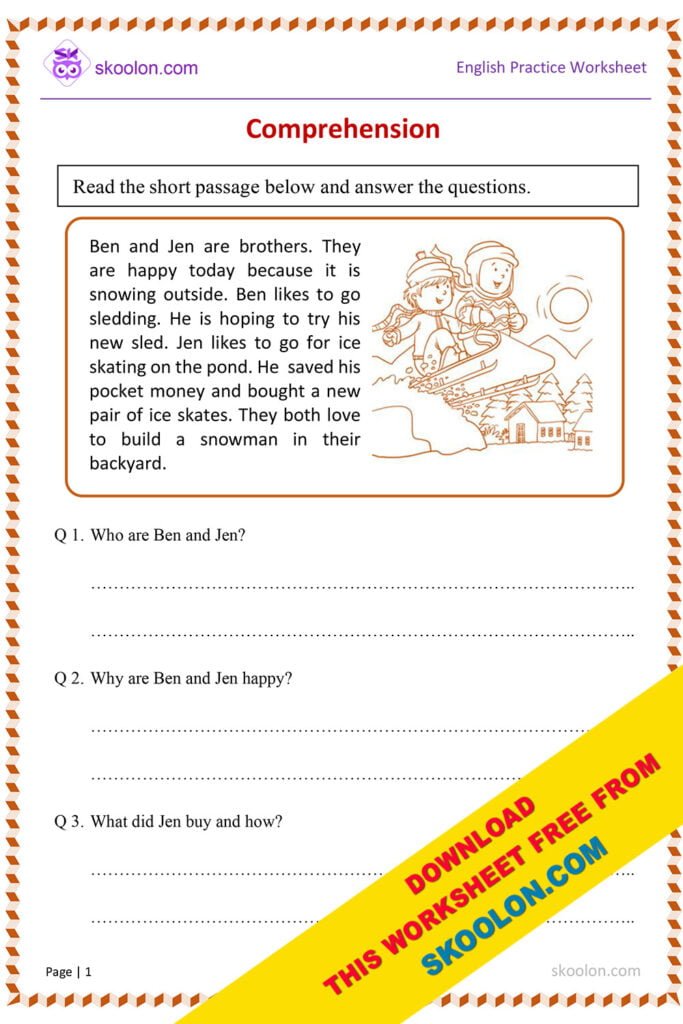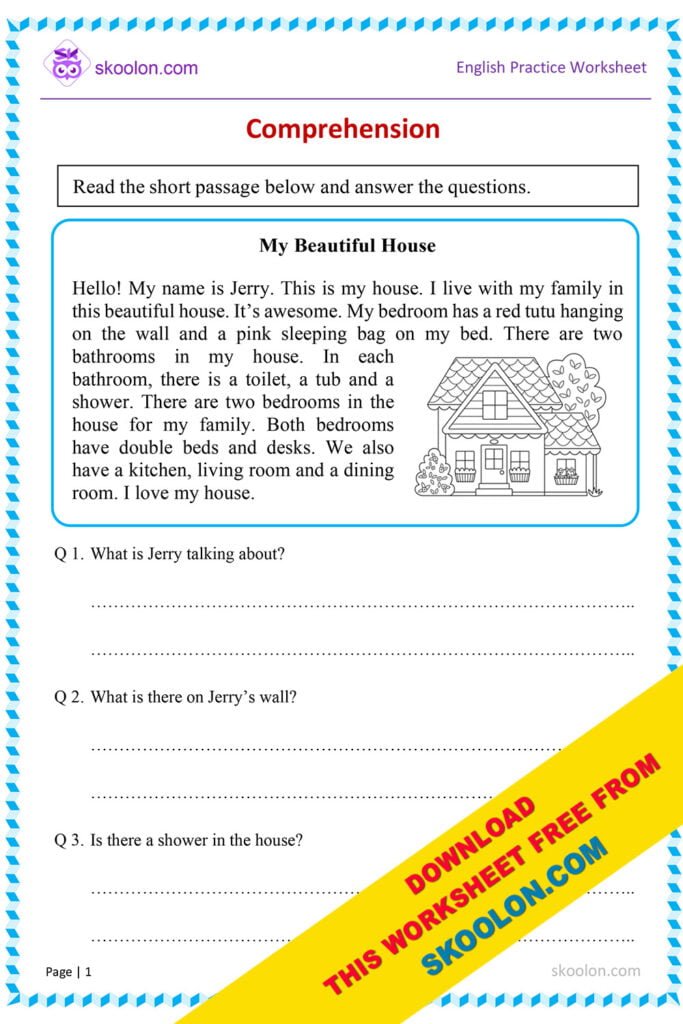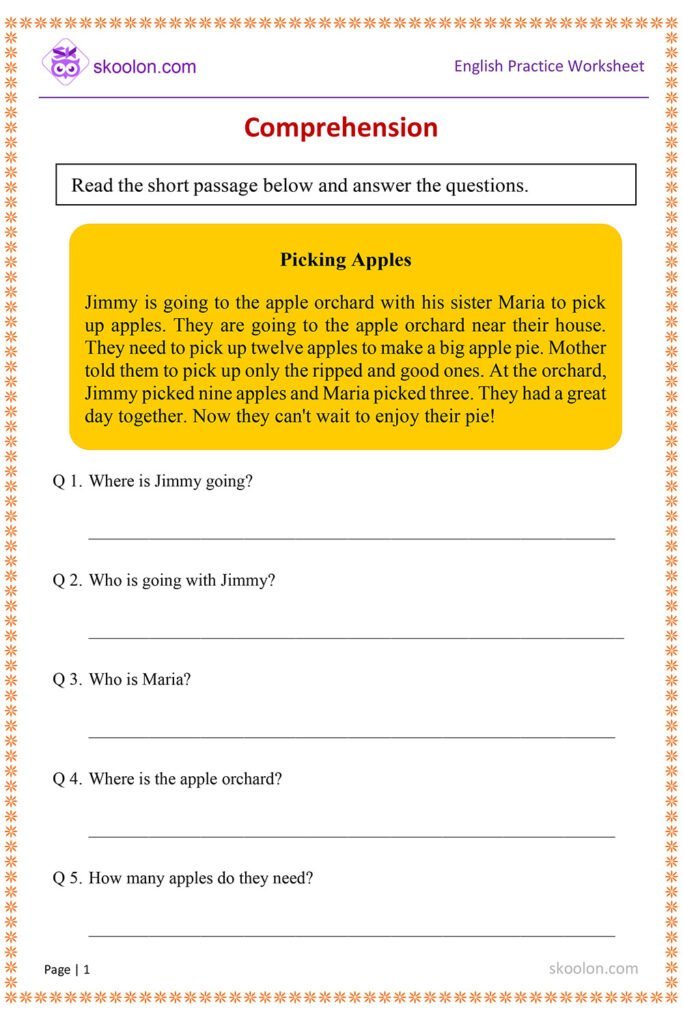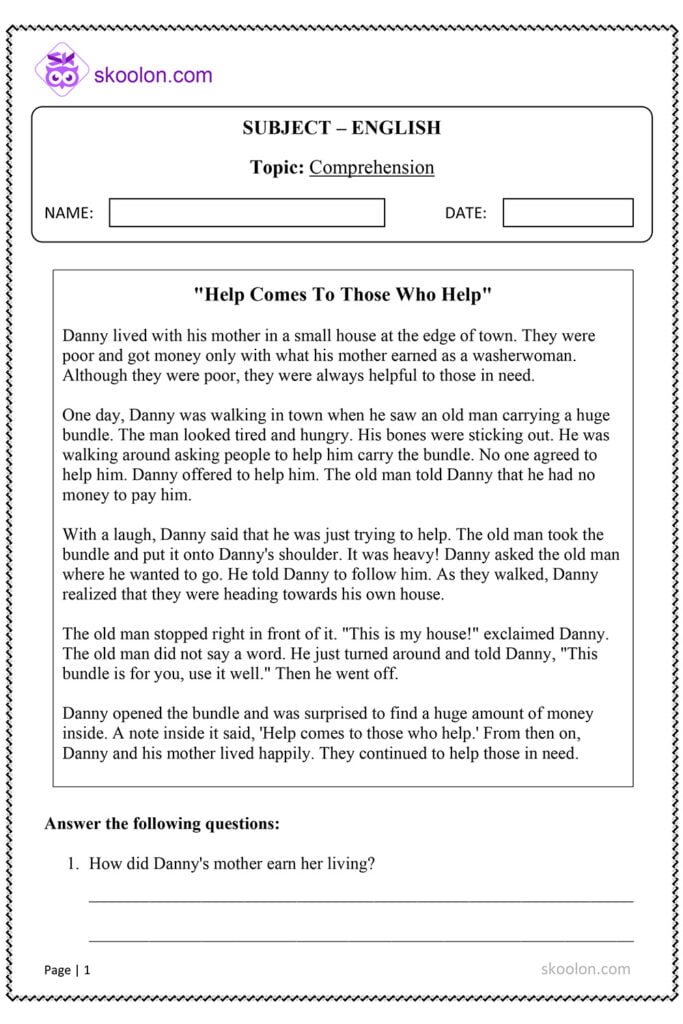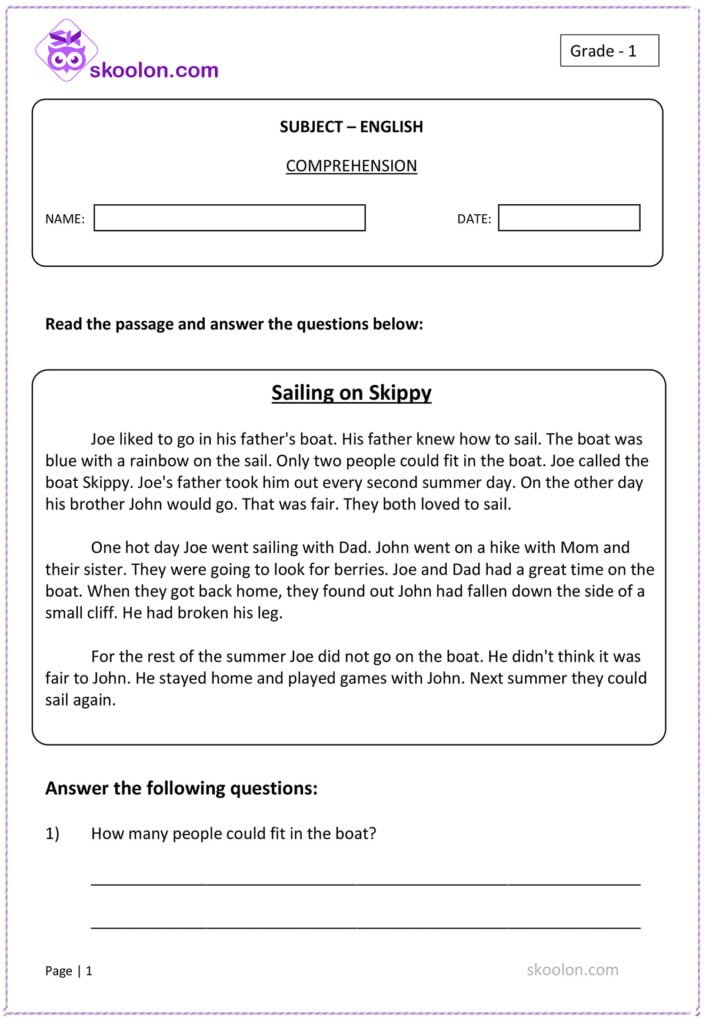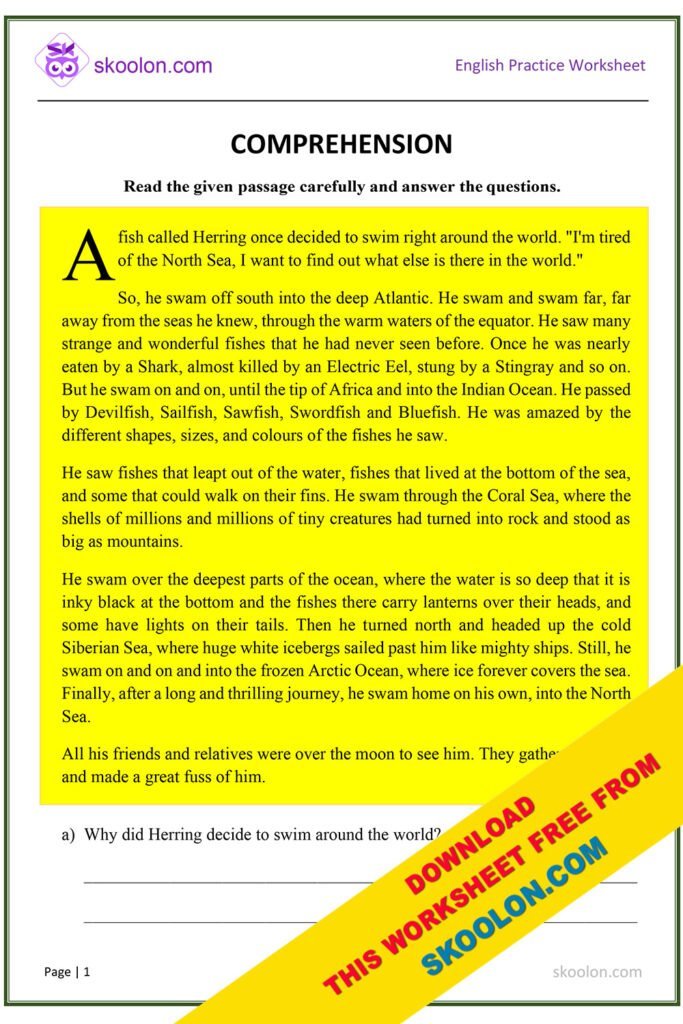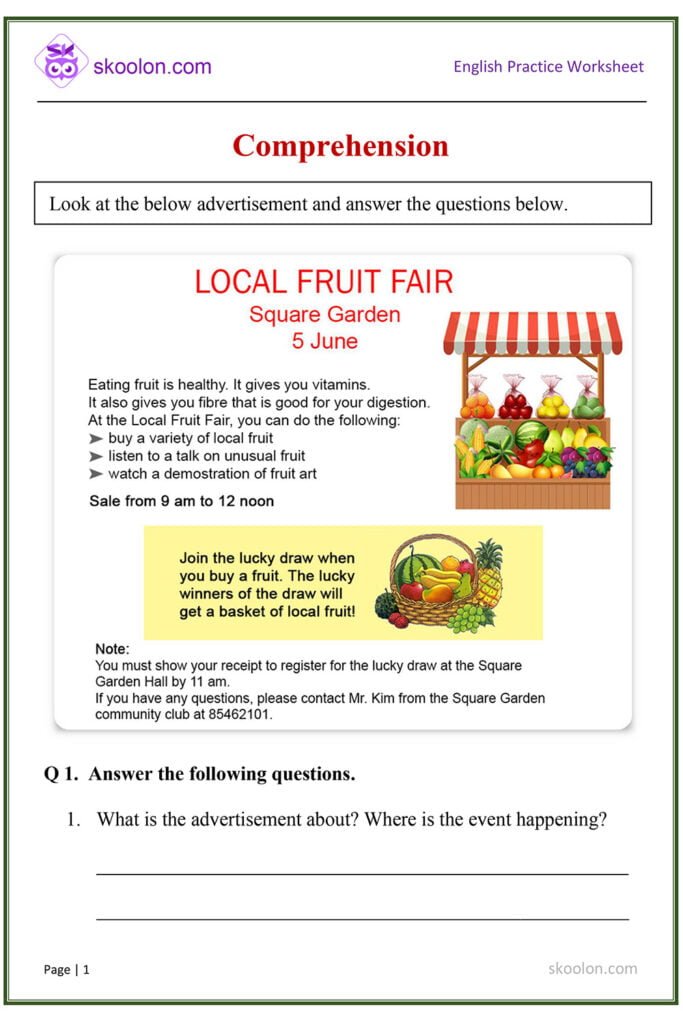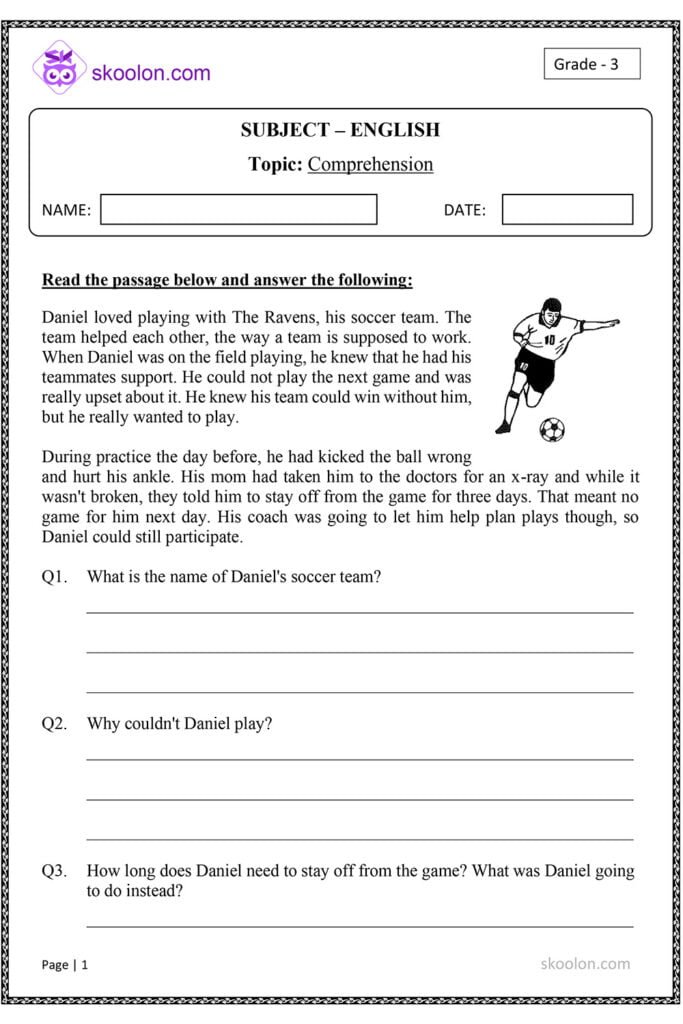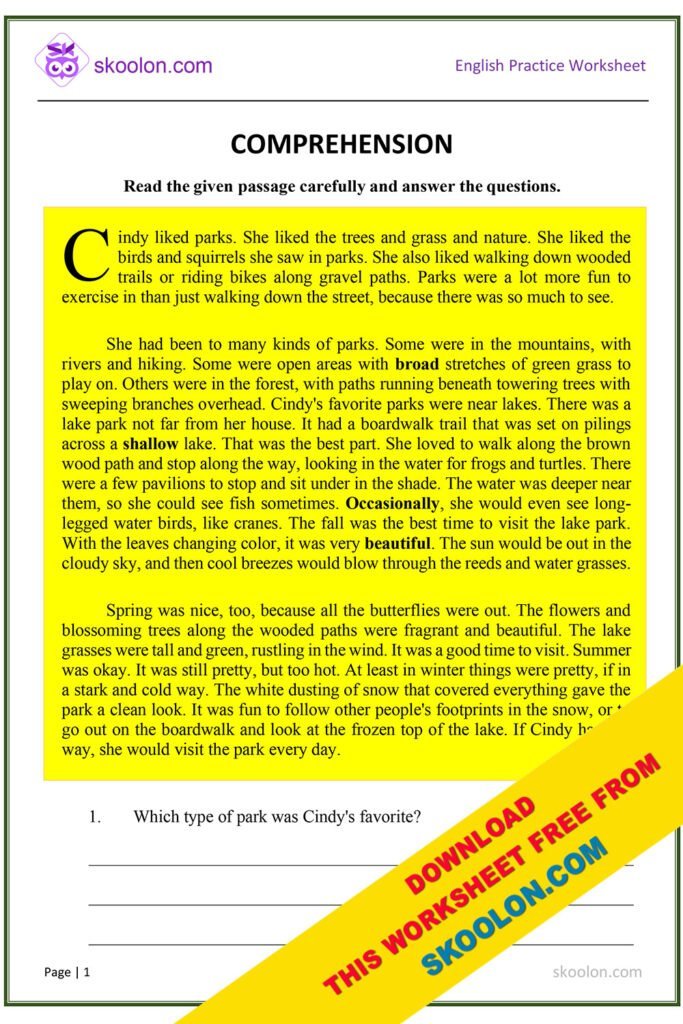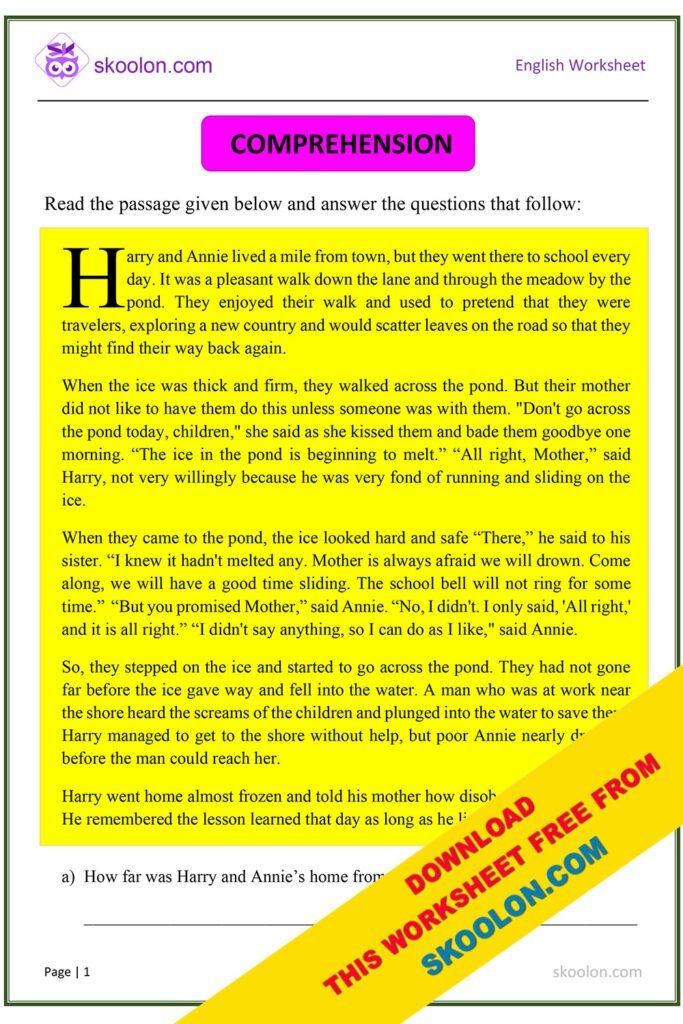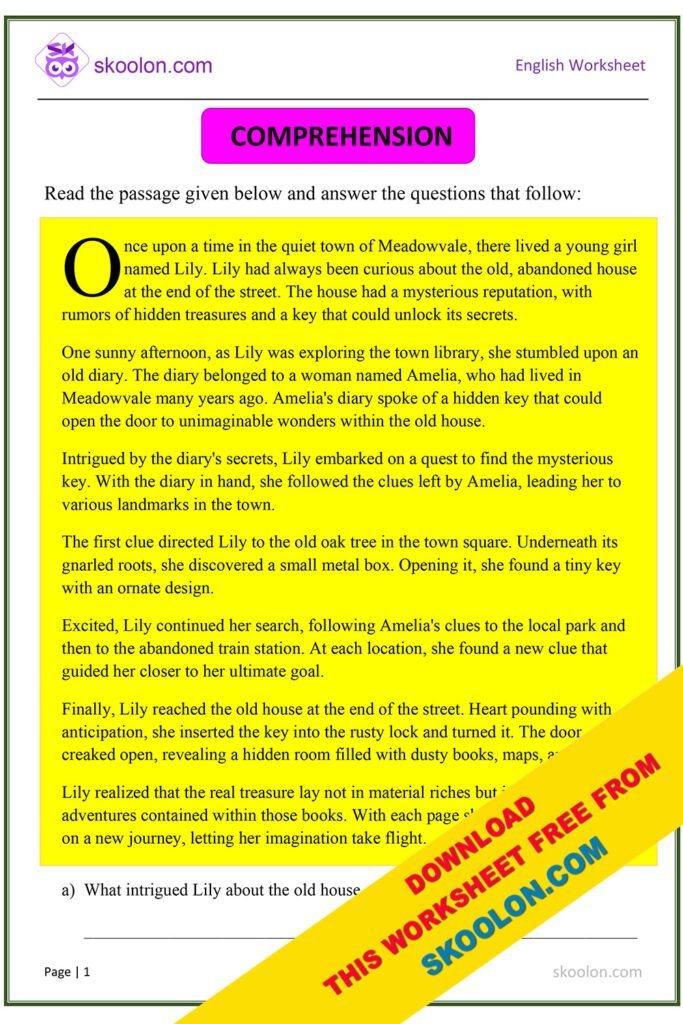
Tips for Developing Comprehension Skills in Young Minds
Note: This comprehensive blog post focuses on developing and improving comprehension skills for students in Grade 1 to Grade 5. We will explore effective strategies, resources, and tips tailored to each grade level, ensuring a strong foundation in comprehension. Get ready to enhance your reading and understanding abilities!
- Introduction to Comprehension
- What is Comprehension?
- Importance of Comprehension Skills
- Ways to Improve Comprehension Skills in Children
- Comprehension for Different Grade Levels
- Grade 1: Building the Foundation
- Grade 2: Expanding Comprehension Skills
- Grade 3: Developing Inference Skills
- Grade 4: Analyzing Texts and Drawing Conclusions
- Grade 5: Mastering Complex Comprehension Skills
- Additional Tips for All Grade Levels
- Understanding Comprehension Passages
- Structure and Components
- Types of Questions
- Strategies for Effective Comprehension
- Pre-reading Techniques
- Active Reading Strategies
- Note-taking and Summarizing
- English Comprehension for Different Grades
- Resources for Comprehension Practice
- Common Challenges in Comprehension
- Tips for Overcoming Comprehension Challenges
- Tips to Boost Comprehension Skills in Young Learners
- Resources for Comprehension Practice
- Sample Comprehension Passages
- Comprehension for Class 1
- Comprehension for Class 2
- Comprehension for Class 3
- Comprehension for Class 4
- Comprehension for Class 5
- FAQs (Frequently Asked Questions)
Introduction: The Power of Comprehension
Comprehension is a fundamental skill that enables us to understand, interpret, and extract meaning from written texts. It goes beyond simple reading and involves the ability to make connections, draw inferences, and comprehend the purpose and context of a passage. Developing comprehension skills is essential for academic success, effective communication, and lifelong learning.
What is Comprehension?
Comprehension, in the context of education, refers to the ability to understand and derive meaning from written and spoken language. It involves actively engaging with the text, processing information, and making connections to prior knowledge. Comprehension goes beyond simply decoding words; it encompasses understanding the main idea, identifying key details, and drawing inferences.
Importance of Comprehension Skills
Having good comprehension skills is essential for both academic and real-life situations. When students possess strong comprehension abilities, they can grasp complex ideas, analyze information critically, and communicate their thoughts effectively. Comprehension skills are particularly vital in subjects like English language arts, where students are required to read and understand various literary texts.
Comprehension is the ability to understand and retain what one has read. It is an essential skill for academic success, as it helps children to:
Build Vocabulary
Reading comprehension helps children to learn new words and understand their meanings. Children who comprehend what they read have a better vocabulary and can express themselves more effectively.
Enhance Critical Thinking
Reading comprehension encourages critical thinking in children. It enables them to evaluate, analyze and interpret what they read, which can help develop their cognitive abilities.
Improve Memory Retention
Comprehension helps children to remember what they have read. By comprehending and retaining what they read, children can recall information later, which can help them in their studies.
Develop a Love for Reading
Children who comprehend what they read are more likely to develop a love for reading. Reading can be a source of entertainment and knowledge, and children who comprehend what they read are more likely to enjoy it.
Ways to Improve Comprehension Skills in Children
Improving comprehension skills in children is crucial for their academic success. Here are some effective ways to improve comprehension skills in children:
Reading Aloud
Reading aloud to children is an effective way to improve their comprehension skills. It helps children to hear the pronunciation of words, which can help build their vocabulary. Reading aloud can also help children to understand sentence structure, punctuation, and tone.
Encouraging Active Reading
Encouraging active reading can improve comprehension skills in children. Active reading involves engaging with the text by asking questions, making connections, and visualizing what is being read. This can help children to retain information and understand the text better.
Using Graphic Organizers
Graphic organizers can help children to visualize the structure of the text and organize their thoughts. They can be used to identify the main idea, supporting details, and the sequence of events. Graphic organizers can be an effective tool for improving comprehension skills in children.
Building Background Knowledge
Building background knowledge can help children to comprehend what they read. Children who have prior knowledge of a topic can better understand and retain the information they read. Parents and teachers can build background knowledge by discussing the topic before reading, introducing related vocabulary, and using real-life examples.
Encouraging Independent Reading
Encouraging independent reading can help children to develop their comprehension skills. Children who read independently can practice their comprehension skills by reading at their own pace and focusing on areas they need to improve.
Comprehension for Different Grade Levels
Comprehension skills are developed and refined at different grade levels to align with the cognitive abilities and reading levels of students. Let’s explore the comprehension requirements for different class levels:
Grade 1: Building the Foundation
In Grade 1, students begin their journey towards strong comprehension skills. Here are key strategies and resources to support their development:
- Reading Aloud: Encourage students to read aloud to improve their phonemic awareness and decoding skills. This helps build a strong foundation for comprehension.
- Picture Books: Utilize picture books with simple texts to engage young readers. Encourage them to describe the characters, settings, and events, fostering their understanding of the narrative.
- Questioning Techniques: Ask students questions about the story, encouraging them to provide answers based on the text. This helps develop their ability to find information directly from the passage.
- Engaging Resources: Explore online platforms that offer interactive comprehension activities and games suitable for Grade 1 students. These resources make learning engaging and enjoyable.
Grade 2: Expanding Comprehension Skills
In Grade 2, students progress further in their comprehension journey. Here’s how to foster their growth:
- Vocabulary Development: Introduce new words and discuss their meanings in the context of the story. This expands their vocabulary and enhances understanding.
- Story Retelling: Encourage students to retell stories in their own words, focusing on the main events, characters, and settings. This strengthens their comprehension and oral communication skills.
- Making Connections: Help students make connections between the text and their own experiences or prior knowledge. This aids in understanding and relating to the content.
- Online Reading Platforms: Utilize online platforms that offer leveled reading materials and comprehension exercises suitable for Grade 2 students. These platforms provide targeted practice and progress tracking.
Grade 3: Developing Inference Skills
In Grade 3, students delve deeper into comprehension and begin to develop inference skills. Consider the following strategies:
- Inferential Questions: Ask students questions that require making inferences based on the text. Encourage them to support their answers with evidence from the passage.
- Identifying Story Elements: Guide students in identifying story elements such as the plot, characters, and conflicts. Discuss how these elements contribute to understanding the overall meaning.
- Note-taking and Summarizing: Introduce note-taking and summarizing techniques. Encourage students to take brief notes while reading and summarize the passage in their own words, highlighting the main ideas.
- Digital Resources: Explore online platforms that offer interactive comprehension passages with questions and answers. These resources provide opportunities for independent practice and skill reinforcement.
Grade 4: Analyzing Texts and Drawing Conclusions
Grade 4 students develop higher-level comprehension skills, analyzing texts and drawing conclusions. Here’s how to support their growth:
- Critical Thinking Activities: Engage students in critical thinking activities that require analyzing the text, making inferences, and drawing conclusions. Encourage them to justify their answers with evidence.
- Identifying Author’s Purpose: Discuss the author’s purpose in writing a text. Encourage students to recognize and understand different purposes such as informing, entertaining, or persuading.
- Textual Evidence: Teach students to find and cite textual evidence to support their answers. This helps develop their ability to draw conclusions based on information provided in the passage.
- Comparing and Contrasting: Introduce activities that require students to compare and contrast different texts or characters. This strengthens their comprehension and critical thinking skills.
- Literary Elements: Explore literary elements such as symbolism, figurative language, and themes. Help students analyze how these elements contribute to the overall meaning of a text.
Grade 5: Mastering Complex Comprehension Skills
In Grade 5, students refine their comprehension skills and tackle more complex texts. Here’s how to support their mastery:
- Analyzing Text Structure: Teach students to analyze different text structures, such as cause and effect, problem and solution, or compare and contrast. This enhances their understanding of the passage’s organization.
- Interpreting Figurative Language: Explore figurative language, such as similes, metaphors, and idioms. Help students interpret their meanings and understand how they enhance the text.
- Drawing Inferences: Encourage students to draw inferences based on implicit information and evidence in the text. Provide opportunities for discussion and support their inferences with textual evidence.
- Critical Reading Strategies: Guide students in using critical reading strategies, such as predicting outcomes, questioning the text, and evaluating the author’s message. This develops their analytical thinking skills.
- Independent Reading: Foster a love for independent reading by providing a wide range of age-appropriate books and encouraging students to explore different genres. Independent reading enhances comprehension skills and fosters a lifelong love for reading.
Additional Tips for All Grade Levels
Regardless of the grade level, these tips can further enhance comprehension skills:
- Active Reading: Encourage students to actively engage with the text by underlining key points, jotting down notes, and highlighting important information. This promotes focus and improves retention.
- Vocabulary Expansion: Regularly introduce new vocabulary words and provide opportunities for students to use them in context. This expands their word knowledge and aids comprehension.
- Discussion and Reflection: Create a supportive environment for students to discuss their thoughts, questions, and reflections about the texts they read. This promotes deeper understanding and critical thinking.
- Regular Practice: Provide ample opportunities for students to practice comprehension skills through varied texts, questions, and activities. Regular practice strengthens their abilities over time.
Understanding Comprehension Passages
Comprehension passages are carefully crafted texts designed to test a reader’s understanding of the content. They consist of several components, including an introduction, body paragraphs, and a conclusion. Within these passages, various types of questions are posed to assess the reader’s comprehension. Some common question types include multiple-choice, short answer, and open-ended questions.
Strategies for Effective Comprehension
To improve comprehension skills, students can utilize several strategies that enhance their reading and understanding abilities. Here are some key strategies:
Pre-reading Techniques:
Before diving into a passage, it’s helpful to preview the text. Skim the headings, subheadings, and bolded text to gain a general idea of the content. By doing this, you activate prior knowledge and create an understanding framework in your mind.
Active Reading Strategies:
While reading, employ active reading techniques such as highlighting or underlining important information, jotting down notes in the margins, or using sticky notes to mark key sections. This enhances engagement and helps in later review.
Note-taking and Summarizing:
Take brief notes while reading to capture main ideas, supporting details, and any questions or reflections that arise. Summarize the passage in your own words, highlighting the essential points. This aids in consolidating information and reinforcing understanding.
English Comprehension for Different Grades:
English comprehension skills develop and become more sophisticated as students progress through different grades. For Grade 3, students are introduced to basic comprehension passages that focus on understanding the main idea, identifying key details, and making simple inferences. For Grade 4, focus on analyzing character motivations, understanding cause and effect relationships, and interpreting figurative language. In Grade 5, emphasize making inferences, analyzing themes and symbolism, and evaluating author’s craft.
Resources for Comprehension Practice:
Utilize various resources to practice comprehension skills. Look for comprehension passages with questions and answers, English worksheets specifically designed for your grade level, and short passage exercises to enhance reading comprehension. Additionally, explore online platforms that offer interactive comprehension activities and practice tests.
Common Challenges in Comprehension:
Comprehension can present certain challenges for students. Some common difficulties include encountering unfamiliar vocabulary, understanding complex sentence structures, and making inferences based on implicit information.
Tips for Overcoming Comprehension Challenges:
To overcome these challenges, consider the following tips:
- Expanding Vocabulary: Read widely and actively learn new words. Use context clues, dictionaries, and vocabulary-building exercises to enhance your word knowledge.
- Practicing Inference Skills: Look for clues within the text, such as descriptive language or character actions, to make logical inferences. Practice drawing conclusions based on implicit information.
- Enhancing Reading Speed: Improve reading fluency by setting aside dedicated time for regular reading practice. Gradually increase your reading speed while maintaining comprehension.
Tips to Boost Comprehension Skills in Young Learners
As young learners embark on their educational journey, developing comprehension skills becomes essential for their academic success. Comprehension is not only about reading the words on a page but also understanding and making meaning from the text. It is a skill that can be nurtured and enhanced through effective strategies and techniques. In this blog, we will explore valuable tips to boost comprehension skills in young learners and set them on the path to becoming confident readers and critical thinkers.
Start with Pre-Reading Activities
Before diving into a text, engage young learners in pre-reading activities to activate their prior knowledge and build anticipation. Ask questions, make predictions, or connect the topic to their own experiences. This prepares them to connect new information with what they already know.
Teach Vocabulary in Context
Expand young learners’ vocabulary by introducing new words in the context of the text they are reading. Help them understand the meaning of unfamiliar words by providing definitions, examples, and related visuals. Encourage the use of context clues to decipher word meanings.
Encourage Active Reading
Teach young learners to actively engage with the text as they read. Encourage them to underline or highlight key information, jot down questions or thoughts in the margins, and make connections to their own experiences or other texts. Active reading promotes deeper comprehension and helps retain information.
Ask Questions
Encourage young learners to ask questions before, during, and after reading. Questions help them focus their attention, clarify understanding, and stimulate critical thinking. Model different types of questions, such as factual, inferential, and evaluative, to enhance comprehension.
Practice Summarizing
Guide young learners in summarizing the main ideas or events from a text. Summarizing requires them to identify the most important information and express it in their own words. This helps consolidate understanding and reinforces the ability to distinguish between essential and non-essential details.
Visualize the Text
Encourage young learners to create mental images while reading. Visualization helps them form a deeper connection with the text and enhances comprehension. Guide them in imagining the characters, settings, or events described, and discuss how visualizing enhances understanding.
Make Predictions
Promote the skill of making predictions based on textual clues. Encourage young learners to use the information provided in the text to anticipate what might happen next or how the story might unfold. This fosters engagement, critical thinking, and active involvement in the reading process.
Foster Active Listening
Comprehension skills extend beyond reading. Encourage young learners to actively listen to stories, lectures, or instructions. Engage them in discussions or ask them to summarize what they heard. Active listening enhances their ability to understand and extract meaning from spoken language.
Encourage Retelling
Provide opportunities for young learners to retell stories or explain concepts in their own words. Retelling requires them to recall and organize information, reinforcing comprehension and communication skills. Encourage creativity and support their retelling efforts with constructive feedback.
Scaffolded Support
Provide scaffolded support to meet young learners at their current comprehension level and gradually increase the complexity of texts. Begin with texts that align with their abilities and gradually introduce more challenging materials. This gradual progression builds confidence and competence.
Use Graphic Organizers
Utilize graphic organizers such as story maps, Venn diagrams, or concept webs to help young learners visually organize their thoughts. These tools aid in identifying main ideas, supporting details, and the relationships between different pieces of information.
Encourage Reading Variety
poetry, and informational articles. This exposes them to different genres, writing styles, and perspectives, enhancing their comprehension skills across various types of texts.
Provide Reading Aloud Opportunities
Reading aloud to young learners not only exposes them to rich language but also models fluent reading and proper intonation. It allows them to focus on comprehension without the added challenge of decoding words, and helps develop their listening and comprehension skills simultaneously.
Promote Discussion and Collaboration
Encourage young learners to engage in discussions about what they have read. Provide opportunities for them to share their thoughts, ask questions, and listen to others’ perspectives. Collaborative discussions foster critical thinking, deepen comprehension, and promote social interaction.
Integrate Technology
Incorporate educational technology tools and resources to support comprehension skill development. Interactive reading apps, digital quizzes, and online reading comprehension exercises can engage young learners and provide immediate feedback, reinforcing their understanding.
Monitor Progress
Regularly assess young learners’ comprehension skills to monitor their progress and identify areas for improvement. Use informal methods such as class discussions, reading responses, or one-on-one conversations. Formal assessments, like comprehension tests, can provide valuable insights as well.
Provide Supportive Environment
Create a supportive and encouraging environment for young learners to develop their comprehension skills. Foster a love for reading by designing cozy reading corners, celebrating reading achievements, and providing access to a variety of age-appropriate and engaging books.
Connect Reading to Real-Life Experiences
Help young learners see the relevance of comprehension skills in their daily lives. Connect reading to real-world scenarios, such as following instructions, interpreting signs, or understanding news articles. This bridges the gap between reading and practical application.
Set Goals and Celebrate Achievements
Track the progress of young learners’ comprehension skills by setting goals. You can boost their confidence and motivation by celebrating their accomplishments, no matter how small. Recognize their efforts and provide constructive feedback to support their continued growth.
Foster a Love for Reading
Above all, foster a love for reading in young learners. Encourage independent reading by providing access to a variety of books and creating dedicated time for reading in the classroom. Instilling a love for reading will fuel their desire to comprehend and explore new texts.
In conclusion, boosting comprehension skills in young learners is a fundamental aspect of their educational journey. By implementing these tips and strategies, educators can empower young minds to become confident readers, critical thinkers, and lifelong learners. Remember, comprehension is not just about decoding words, but about making meaning from the text. Let’s support and nurture the growth of comprehension skills in our young learners, laying a strong foundation for their academic success and beyond.
Developing English Comprehension Skills
Comprehension for Class 1
Sample Comprehension for Grade 1 :
Tom has a pet cat named Mittens. Mittens is white and fluffy. Tom likes to play with Mittens in the backyard. They chase butterflies and roll in the grass. Mittens purrs when Tom pets her. Tom loves his cat.
Questions:
What is the name of Tom’s pet cat?
What color is Mittens?
Where do Tom and Mittens play?
What sound does Mittens make when Tom pets her?
Download Comprehension for Class 1
Comprehension for Class 2 :
Sample Comprehension for Grade 2 :
Lucy is going on a field trip to the zoo. She is excited to see all the animals. Lucy’s favorite animal is the giraffe. She loves their long necks and spots. Lucy hopes she can feed the giraffes. She will bring her camera to take pictures.
Questions:
Where is Lucy going on a field trip?
What is Lucy’s favorite animal?
What does Lucy like about giraffes?
What will Lucy bring to the zoo?
Download Comprehension for Class 2
Comprehension for Class 3 :
Sample Comprehension for Grade 3 :
One sunny afternoon, Sarah and her friends decided to explore the nearby forest. They packed some snacks, put on their hiking shoes, and set off on their adventure. As they entered the forest, they were greeted by tall trees and the sweet chirping of birds. They followed a narrow trail that led them deeper into the woods. Sarah noticed colorful wildflowers blooming along the path. Suddenly, they heard a rustling sound. They turned around to see a deer gracefully leaping through the bushes. Excitedly, they continued their exploration and came across a sparkling stream. They dipped their feet in the cool water and splashed each other playfully. After resting for a while, they made their way back home, cherishing the memories of their forest adventure.
Questions:
Where did Sarah and her friends decide to explore?
What did Sarah notice along the trail in the forest?
What sound did they hear that made them turn around?
What did they find when they continued their exploration?
How did Sarah and her friends feel about their forest adventure?
Download Comprehension for Class 3
Comprehension for Class 4 :
Sample Comprehension for Grade 4 :
Mount Everest, also known as Sagarmatha in Nepal, is the highest peak in the world. Standing at an impressive height of 8,848 meters, it is a coveted destination for mountaineers and adventurers from all around the globe. Scaling Mount Everest is an arduous and challenging feat that requires months of preparation and a high level of physical fitness.
The journey to the summit begins at the base camp located at an altitude of about 5,364 meters. From there, climbers embark on a series of treacherous ascents, navigating through perilous icefalls, steep cliffs, and unpredictable weather conditions. They have to face the notorious Khumbu Icefall, a constantly shifting and dangerous section of the climb.
As climbers ascend higher, they encounter the “Death Zone,” an area above 8,000 meters where the oxygen level is dangerously low, making it extremely difficult for the human body to function. At this altitude, climbers are at risk of altitude sickness and other life-threatening conditions. Despite these challenges, the allure of reaching the summit continues to draw adventurers.
Reaching the top of Mount Everest is a significant achievement that requires immense determination, resilience, and teamwork. Along the way, climbers rely on experienced Sherpa guides who have extensive knowledge of the mountain and its routes.
However, climbing Mount Everest is not without its risks. The unforgiving nature of the mountain has claimed the lives of many climbers throughout history. Avalanches, crevasses, and extreme cold are constant threats. It is crucial for climbers to be well-equipped with appropriate gear, undergo rigorous training, and make responsible decisions to ensure their safety.
Mount Everest holds a special place in the hearts of the people of Nepal. It is not only a majestic peak but also a symbol of national pride and resilience. The Sherpa people, who have lived in the Everest region for generations, play a crucial role in supporting climbers and maintaining the mountain’s integrity.
Questions:
What is the height of Mount Everest?
What challenges do climbers face during their ascent to the summit?
What is the “Death Zone,” and why is it dangerous?
How do climbers prepare for the climb, and who assists them during the journey?
Why is climbing Mount Everest considered a significant achievement?
What are some risks and dangers associated with climbing Mount Everest?
What role do the Sherpa people play in supporting climbers?
Download Comprehension for Class 4 and 5
FAQs (Frequently Asked Questions)
What is comprehension?
Comprehension refers to the ability to understand and interpret written texts effectively, extracting meaning and making connections between ideas.
How can I improve my comprehension skills?
Practice active reading strategies, such as note-taking and summarizing. Expand your vocabulary, practice inference skills, and read a variety of texts regularly.
What are some common challenges in comprehension?
Common challenges include encountering unfamiliar vocabulary, understanding complex sentence structures, and making inferences based on implicit information.
How can I overcome comprehension challenges?
Overcome comprehension challenges by expanding your vocabulary, practicing inference skills, and enhancing your reading speed through regular practice and exposure to diverse texts.
What is the difference between Comprehension and Unseen Passage?
Comprehension and unseen passage are related concepts but have slight differences:
Comprehension: Comprehension refers to the ability to understand and interpret written or spoken language. It involves grasping the meaning, purpose, and main ideas of a text or passage. Comprehension often focuses on assessing a student’s understanding of a specific text, including its vocabulary, content, and context. Comprehension activities typically involve reading a given text or passage and answering questions to demonstrate understanding. These questions may assess literal comprehension (identifying facts and details directly stated in the text), inferential comprehension (making inferences and drawing conclusions based on the text), and evaluative comprehension (analyzing and critically evaluating the text).
Unseen Passage: An unseen passage, also known as a reading comprehension passage, is a text or excerpt that students encounter for the first time during an assessment or practice activity. It is called “unseen” because students have not read or studied it beforehand. Unseen passages are used to evaluate students’ reading comprehension skills, including their ability to understand, analyze, and respond to a text within a limited timeframe. Students are expected to read the passage carefully, identify important details, infer meaning, and answer questions related to the passage. Unseen passages can come from various genres, such as fiction, non-fiction, poetry, or informational texts.
In summary, comprehension is a broader term that refers to the overall ability to understand and interpret language, while an unseen passage is a specific activity that assesses reading comprehension skills by presenting students with a text they haven’t encountered before and evaluating their understanding through questions. Unseen passages are a common method used to assess comprehension skills in educational settings.
How can I improve comprehension skills for my child in Grade 1?
Encourage reading aloud, engage with picture books, ask questions about the story, and utilize interactive online resources designed for Grade 1 students.
What can I do to help my child develop inference skills in Grade 3?
Encourage your child to answer inferential questions based on the text, identify story elements, take notes while reading, and summarize the passage in their own words. Additionally, provide access to digital resources that offer interactive comprehension activities and passages.
How can I support my child in mastering complex comprehension skills in Grade 5?
Help your child analyze text structures, interpret figurative language, draw inferences, and employ critical reading strategies. Encourage independent reading and provide access to a variety of challenging texts across different genres.
What are some effective strategies for active reading?
Active reading strategies include underlining key points, jotting down notes, highlighting important information, and asking questions while reading. These strategies promote engagement and improve understanding.
How important is vocabulary expansion for comprehension?
Vocabulary expansion is crucial for comprehension as it helps students understand the meanings of words used in the text. Introducing new vocabulary words and providing context for their usage enhances overall comprehension skills.

